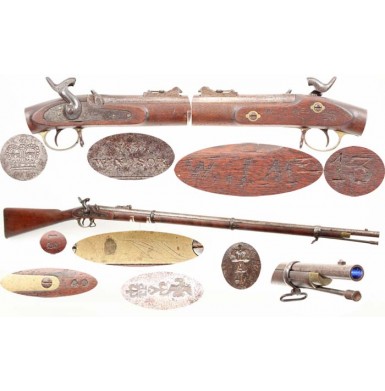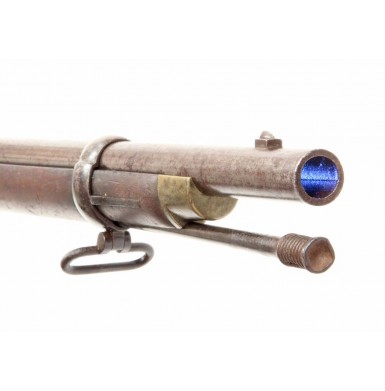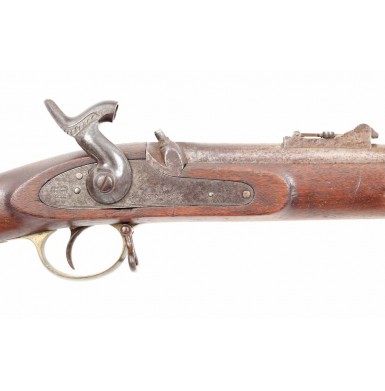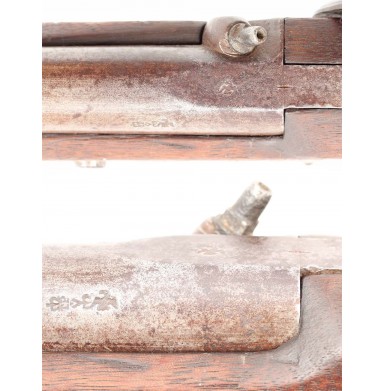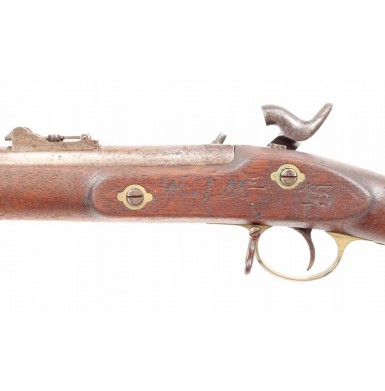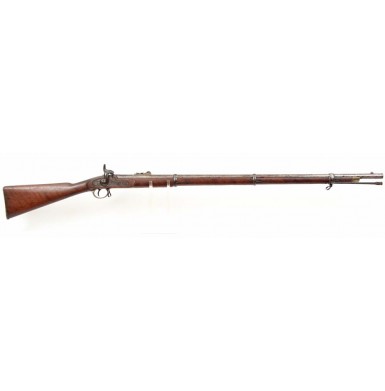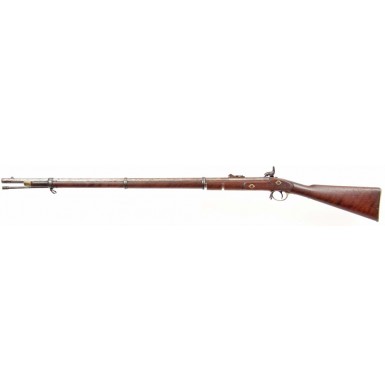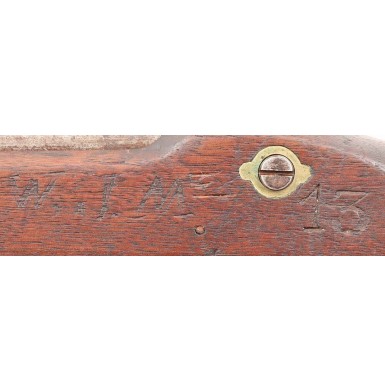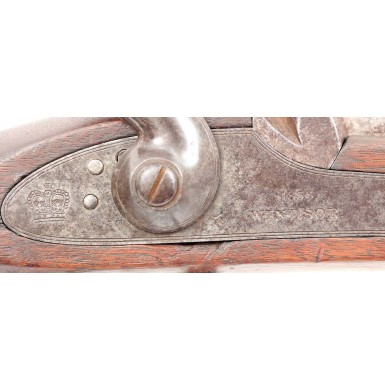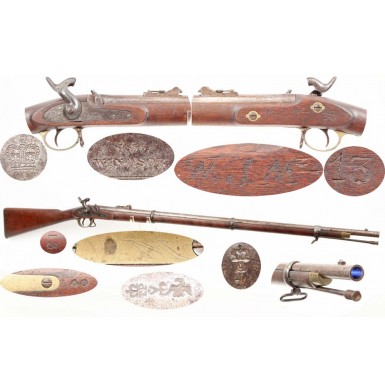Fine & Scarce Windsor Enfield by Robbins & Lawrence
- Product Code: FLA-2998-SOLD
- Availability: Out Of Stock
-
$1.00
This is one of the least common of all the variations of the Pattern 1853 Enfield Rifle Musket. This musket was built in the United States, under contract for the British Government, by the firm of Robbins & Lawrence of Windsor, Vermont. This pattern of gun is what collectors and researchers refer to as a Type II P-1853 rifle musket. The primary features that separate it from the much more common Type III P-1853 (which was the version primarily used during the Civil War), are solid barrel bands that are retained by band springs (instead of screw fastened clamping bands) and a rammer that is retained in the stock by a swell near the tip, similar to the US M-1855/61 rammer. Type III Enfields have their ramrods retained by a spring-loaded “spoon” in the stock. This gun is one of only about 16,000 produced by the Robbins & Lawrence company, and their temporary successor, Vermont Arms. In fact, the production of these guns brought the company to bankruptcy. During the Crimean War, the British government could not produce arms quickly enough to arm their troops, as would be the case less than a decade later in the US during the American Civil War. As a result, they looked to outside sources to build the standard issue arm at the time, the P-1853 rifle musket. They let contracts to makers in Belgium, France and in the United States to have the desperately needed arms produced. They selected the firm of Robbins & Lawrence due to the ability of the company to produce guns with interchangeable parts. In fact much of the machinery and tooling that the British Government had bought for the Royal Small Arms Factory at Enfield Lock had been purchased from Robbins & Lawrence and the American firm had helped set up the British production. Thus they were a natural choice to build excess arms when the British needed them. Expecting orders of between 30,000 and 60,000 arms, Robbins & Lawrence spent huge sums of money tooling up for production and expanding their manufacturing capabilities by adding a second factory in Hartford, CT. However, the Crimean War ended more quickly than anticipated, and the remaining portion of the initial British contract was cancelled, as were any future contracts. The end result was a production run of approximately 10,400 guns that were delivered to the British. The balance of the 16,000 guns produced (5,600) were to be completed by the newly established Vermont Arms Company, which was established by the creditors of Robbins & Lawrence to assemble guns from left over parts on hand, and newly fabricated ones as needed. One of Robbins & Lawrence’s creditors, the New York firm of Fox, Henderson & Company agreed to accept these 5,600 guns to be assembled by Vermont Arms as payment for their credit interest in the now bankrupt company. In 1858 Vermont Arms also failed, and the remaining inventory and assets were sold at auction. The Sharps Rifle Manufacturing Company purchased the Hartford Factory and the Windsor, VT factory was acquired by E.G. Lamson and Able Goodnow. Lamson and Goodnow would later go on to produce US M-1861 Special Model Muskets at this facility under the name of Lamson, Goodnow & Yale (LG&Y) during the Civil War. At the same time the factories were sold, machinery and many parts for as yet un-built guns were sold at auction. Many of these parts ended up in the possession of the Whitney Arms Company and were used in the production of his very rare and odd “good and serviceable” arms. It is noted that Whitney acquired enough parts to fabricate some 4,000 arms at the auction, and also acquired a rifling machine. There is some indication that a small number of the completed guns received by Fox, Henderson & Company were sold to Mexican Nationalist who were revolting against the rule of Emperor Maximillian I in Mexico. New York merchants like Fox, Henderson & Company also sold many of the completed arms to southern states during 1860 and early 1861. The states had purchased the arms in preparation for the Civil War that they were sure was about to happen. Researchers have also determined that at least some “Windsor Enfields” were purchased by the State of South Carolina, with the possibility that as many as 710 were acquired by that state. On January 21, 1861 38 cases of rifled muskets that were being shipped from New York City to Alabama and Georgia were impounded by the New York Police Department. These guns were packed 20 to a case, with 28 of the cases destined for Alabama and 10 headed for Georgia. Period documents note that the 28 cases of guns headed to Alabama were “Robbins & Lawrence Enfields”. The description of the Georgia guns is not so accurate, but does note that the some of the arms were marked with (CROWN) / A over a number on the breech and other parts. These were the marks of the British Board of Ordnance sub-inspectors who were inspecting completed parts at the Robbins & Lawrence factory. While it is not known how many Georgia regiments received the Robbins & Lawrence guns, period documents and images indicate that the Rome Light Guards (Company A of the 8th GA Infantry) were armed with at least some of the “Windsor Enfields”. Additional indications of Southern use appeared in a March of 1861 advertisement from a company in Petersburg, VA listing 100 “Windsor Enfields” for sale. A letter from Confederate Lt. J. Wilcox Brown, dated June 1, 1863, lists “Windsor” among the makers noted on the locks of Enfield arms being repaired at the Richmond Artillery Workshop. He also noted Enfields marked “Tower, Bond, Carr, Barnett & Greener”. All of these period accounts make it clear that a significant number of “Windsor” Enfields ended up in southern hands during the American Civil War. This seems to explain the overall scarcity of the “Windsor” Enfields these days, as many of the later production, non-British military arms, ended up seeing hard service with Confederate soldiers. Those guns that were delivered to the British were quickly deemed 2nd Class as they were of an obsolete pattern (Type II instead of Type III) and most were likely sent to arm colonial and empire forces from Canada to India and everywhere in between.
This particular example of the Robbins & Lawrence Windsor Enfield is in about VERY GOOD+ to NEAR FINE overall condition, especially for a rifle musket that almost certainly saw Confederate service. The gun shows real world use, but no abuse. The gun is clearly marked on the lock with a Crown behind the hammer, and is marked 1856 over WINDSOR forward of the hammer. The lock shows no external British military inspection marks, so it was never inspected as an assembled lock by an Ordnance inspector. The inside of the hammer neck does bear the sub-inspection mark (CROWN) / A / 4. The A was the mark required by the British to indicate the location of manufacture; in this case, America. Likewise on other arms a B indicated Birmingham, E the RSAF at Enfield Lock and L for Liege in Belgium. This mark does not mean the gun saw British military service, it simply means the hammer was inspected by a Board of Ordnance sub-inspector prior to the bankruptcy of the company, and was subsequently incorporated into a complete gun by Vermont Arms after the fact. A similar sub-inspector mark is visible on the reverse of the upper barrel band as well. The barrel is proofed with a (CROWN) / TP / (BROAD ARROW) and a (CROWN) / A / “. The second proof mark has been over-stamped with a crude spread winged eagle that has been encountered on other Windsor Enfields with Confederate provenance. It is not clear if the eagle stamp was done at the factory or by the state that received the guns. This stamp mostly obliterates the sub-inspector mark. The same stamp is also present on the flat on the top of the barrel’s breech. This is another place that is typically marked with an Ordnance Department inspection mark, and this eagle either replaces or obliterates that English inspection mark as well. It is quite common to find a mix of British sub-inspected and un-inspected parts mixed on these post-bankruptcy assembled muskets. The only other markings on the gun are the number 13 stamped clearly on the stock flat and behind the triggerguard, and the number 40 stamped into the comb of the stock forward of the buttplate tang. These numbers suggest the gun was issued to a 13th regiment and was gun number 40 of the regiment or company. The initials W J M are neatly carved on the stock flat and the initials W M are scratched into the brass triggerguard tang. These initials are clearly period and typical of those found on southern used rifles and muskets. More than likely “WJM” served in the 13th Alabama, Georgia or South Carolina, as we know all of those states received Windsor muskets. Some diligent research may well be able to identify the soldier that carried this musket.
Overall the gun has an untouched mottled brown over gray patina. The barrel is mostly smooth with some scattered areas of pinpricking and peppering and some light pitting at the breech and bolster areas, as well as the muzzle. There are also some small areas of lightly scattered oxidized surface roughness present on exposed surfaces of the barrel. The underside of the barrel retains about 80%+ of its original blued finish where it has been protected by the stock, and this area shows only some fading and dulling from age and the heat generated when the gun was fired. The underside of the barrel is marked with a small X at the breech end, a 2 under the bolster, and the series of inspection marks F 3 Y B. The rear face of the breech and the rear of the breech plug are both numbered F 583. The bore of the musket is in about VERY GOOD condition and retains strong three groove, progressive depth rifling. The bore is mostly bright with scattered areas of light oxidation and shows scattered light pitting along its length, with only a few small areas of more moderate pitting. A good scrubbing would probably improve the overall bore condition, but it looks as if it is perfectly serviceable in its current condition. The barrel bands have a dark, smoky blue-black patina that is a mixture of their original blued finish and oxidized age discoloration. The solid bands show some scattered areas of light pitting and minor surface roughness, and all retain between 20% and 40% of their original blue. The barrel band springs have a similar patina, showing a mix of original blue and age discoloration. The lock is in mechanically EXCELLENT condition and function crisply and correctly on all positions. The original cone (nipple) is in place in the bolster and shows moderate wear, commensurate with the balance of the gun. The gun retains its original long-range rear sight, as well as the original front sight/bayonet lug. The original full-length, swelled shank, jag-head ramrod is present in the channel under the barrel as well, and it retains good threads at the opposite end. The original upper sling swivel is in place, riveted to the lug on the upper barrel band. The rear swivel is an original Enfield swivel, but is not original to the gun, as it is trapezoidal in shape, and rear sling swivels of interchangeable parts Enfields (like those from The Royal Small Arms Factory at Enfield - RSAF, and the London Armoury Company) were oval shaped. The patina of the swivel matches the gun perfectly and it could a period of use replacement. The brass furniture has a lovely mustard patina that is very attractive. The musket’s stock is solid, and in VERY GOOD+ to NEAR FINE condition as well. As would be expected, the stock shows the normal bumps, dings and service wear of a 150-year-old military musket. The stock appears to have been lightly cleaned in the past and does show some minor softening of the sharp edges, but this likely the result of wear and use, not sanding. There is a small amount of wood loss at the bottom center of the lock mortise, where it looks like a screwdriver may have been used to pry the lock out of the stock. The wood in this area is worn and smooth, and the inept act is probably from the period of use. There are a few small slivers of wood missing along the edges of the ramrod channel, but this is too be expected and in no way affects the displayability or attractiveness of the musket. The wood appears a little dry, so a light coat of good wood feeding oil like Kramer’s Best might be in order.
Overall this is one of the nicest examples of a Robbins & Lawrence Windsor Enfield that I have had the opportunity to offer for sale. Each year I am lucky to see one or two of these rare guns available for sale, and rarely do I have the chance to buy them. Even Flayderman comments that the Windsor Enfields are “rarely encountered”, and show up far less often than their production figures would indicate that they should. The apparent rarity is likely a result of the fact that these guns all saw combat of some sort. Those that were accepted by the British Government nearly all went to war in the Crimea or were sent to various British colonies where they had a very hard service life. The balance of the guns that were sold off went to Mexican revolutionaries and state militia companies on both sides of the Mason-Dixon Line and were in use from day one of the American Civil War. When these guns are encountered today they are often in very rough condition “ an indication of their hard service life, either in British service or during American Civil War service. This rare example of the Windsor Civil War Enfield is a great example of real Civil War used gun that almost certainly went south before (or at the very beginning of) the war. With a little research you may be able to identify the soldier with the initials “WJM” who served in some 13th infantry regiment, likely in Alabama, Georgia or South Carolina. Don’t miss your chance to obtain a truly scare Windsor Enfield, a gun that you may not see for sale again anywhere for a year or two.
SOLD
